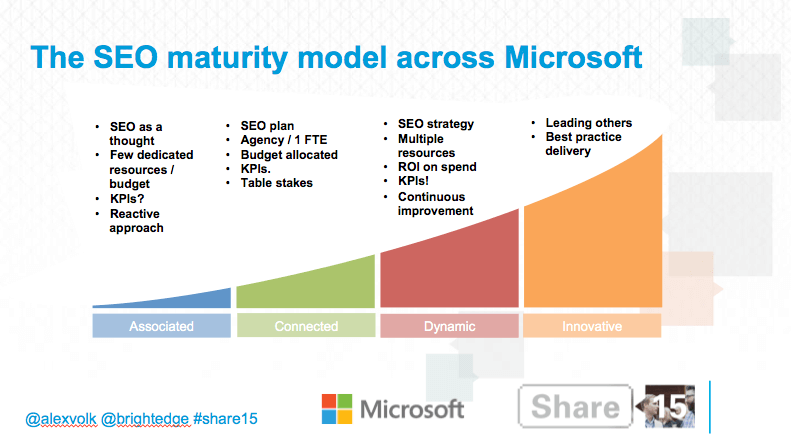The SEO Maturity Curve: Enterprise Scale & Development
How do you take your organization from SEO dabblers to industry leaders? Columnist Jim Yu discusses how to mature your SEO program.

The SEO industry continues to evolve and develop at a lightning pace.
Over the past few years, there have been multiple algorithm updates and changes that have impacted search strategy. Mobile has also become a dominant platform for the online consumer, which means that brands’ messaging must be optimized to meet the demands of these users.
Modern online marketing has also been tremendously affected by the intersection of content, search and social. The silos that once separated the different specialties have quickly been disappearing, as the growing sophistication of both customers and search algorithms means that each area increasingly affects the others.
High-quality content, for example, is more likely to be shared on social media, which increases the engagement and usage metrics measured by Google. As the content ranks higher, it will be more visible, and therefore likely to be shared by an increasing number of people on social media.
The Impact Of Industry Changes On Marketing Jobs
As the growth within the industry has changed how brands use their content and how customers interact with it, the impact on marketing jobs themselves has been incredible. Brands now recognize that their professionals must have two things:
- Skill sets that branch out beyond their specialty, so they can contribute to the overall marketing goals.
- Interpersonal skills that allow them to effectively collaborate with other departments.
Many marketers enter the industry with distinct specialties in which they excel; however, in a world without marketing silos, this does little good. These professionals must learn how to translate their skills into related specialties, such as content development and SEO, or email marketing and analytics.
Marketers must be able to see the bigger picture to understand how their role fits with the goal of the campaign. They must also be able to effectively collaborate with other departments to ensure that their efforts reflect the holistic approach needed in modern marketing.
What These Changes Mean For SEO
As the entire online marketing industry has grown and evolved, so have SEO best practices and strategies. Like the rest of the marketing specialties, optimizing for search has become less siloed from the rest of the marketing efforts. SEO now represents a cross-channel effort.
That doesn’t mean SEO has become less important — organic search remains the strongest single driver of traffic. According to a recent study, it is responsible for 51 percent of website traffic, thus ensuring that SEO is a vital part of any successful online content strategy.
Brands need to have the talent and the collaboration in place to incorporate SEO into their wider marketing goals. The ability of a brand to scale content to meet the growing needs of the company while also optimizing it for search is a major indicator of the maturity of the business’s online marketing efforts.
The SEO Maturity Curve
Businesses must now be in a state of constant growth. Content fuels enterprises across multiple departments as collaboration and holistic marketing become commonplace. The importance of search means that this content needs to be optimized and prepared to function well across the marketing landscape.

Source: Alex Volk, Director of Traffic and Content Strategy, Microsoft at Share15
There is a maturity process that can be used to describe how well businesses are meeting this challenge, from those in the naissance of SEO and content optimization to those who have become industry experts. There are four main stages in this development.
- Stage One: These businesses have begun to recognize the value and importance of SEO, but they are not prepared to take advantage of the potential. SEO is not viewed as a priority, there are no KPIs, there is no budget and few resources are available.
- Stage Two: These businesses have begun to take steps to leverage SEO potential. They have outlined a strategy and have begun to look at KPIs that might be valuable for their organization.
- Stage Three: These businesses now have strong SEO strategies in place and are seeing positive, measurable ROI in exchange for their efforts. They regularly use KPIs and look for ways to improve their methods.
- Stage Four: These are the businesses that lead the rest. They understand SEO best practices and put them to use. At the same time, they are looking for ways to innovate and discover new, ground-breaking techniques.
As businesses mature along this curve, they are capable of employing highly efficient content production teams that can scale to meet their needs and be the cornerstone of the rest of the online and digital marketing efforts.
Growing Along The Curve
For businesses to progress along the maturity curve, the place to begin is the establishment an atmosphere of collaboration. Many brands will find that their existing content needs to be organized and properly optimized to gain an accurate picture of what resources exist currently and what still needs to be developed.
The different marketing teams should work together to strategically classify existing content. There are tools available that can help brands identify keywords, competitors and other insights that will let them know where their gaps in content lie and what customers want to see.
It will also be important to demonstrate the value of SEO to the business leaders. This can be done through running pilot test projects. By selecting a few keywords that have strong usage and optimizing content to meet the needs of users, you will be able to demonstrate the results that can be seen by prioritizing search optimization.
Once marketers receive the green light from the company heads, they will be able to begin the growth that can lead them to stage three. They can experiment with KPIs to see which are most meaningful for their organization. They can try different strategies and measure their results. As they become better at understanding the needs of their audience, they will begin to see positive ROI and be able to refine their efforts. They will produce more effective content and do it more efficiently.
To reach the top of the curve, however, companies must be willing to take risks. Becoming a leader in the SEO world means prioritizing innovation and being willing to explore new avenues that have not been tried before. It is in these experiments that leaders establish themselves with original techniques.
It is important to note that true growth along the maturity curve requires making decisions based upon facts and data, rather than just intuition and guesses.
A comprehensive dashboard that can help you monitor your progress and rankings in SERPs, how you measure up to competitors and your Share of Voice will let you see how well your efforts are helping you reach your goals. You will not be able to reach the latter end of the growth curve without proper measurements.
Steps To SEO Maturity
1. Understand the impact of organic search on how brands organize departments. As brands better understand the role of organic search in company visibility and traffic, they will become more inspired to mature their operations and better meet the needs of customers.
2. Benchmark where your company fits into the organic in-house maturity curve. Businesses should pay attention to where they fall on the maturity curve. This will let them see what the next step should be and where they need to grow to be able to move up a level.
3. Report and scale content across multiple departments and business units. Take advantage of the content’s potential by scaling it across the business’ departments to better serve customers.
4. Build dashboards that measure and report SEO performance across multiple business functions, including the C-suite. As brands begin to upgrade their SEO strategies, it will be important to build a personalized dashboard that lets them measure and see results across the different business functions. It will offer the data craved by those in the C-suites, while also providing marketers with direction for future campaigns.
The growth and evolution of the marketing industry have led to numerous changes for businesses. Their marketing departments must now adopt a policy of collaboration across specialties to appropriately address their intended audiences. Effective marketers also cannot confine themselves to a single set of skills. This has affected how companies have approached SEO — morphing it into a component that must be carefully woven into the entire marketing strategy.
Content lies at the cornerstone of these marketing changes. This content must be optimized to attract the attention of users. This requires scaling content and the maturing of search optimization efforts as a whole.
As brands begin to see the value in producing this optimized content that can be used across departments, they should leverage the tools available, and be mindful of where they fall on the maturity curve, so they can take content performance to the next level.
Contributing authors are invited to create content for Search Engine Land and are chosen for their expertise and contribution to the search community. Our contributors work under the oversight of the editorial staff and contributions are checked for quality and relevance to our readers. The opinions they express are their own.
Related stories
New on Search Engine Land